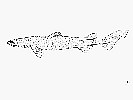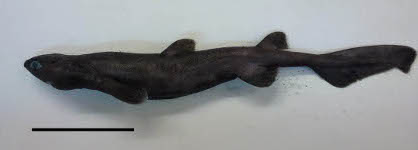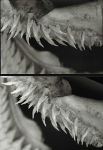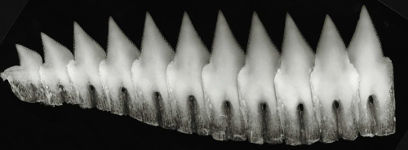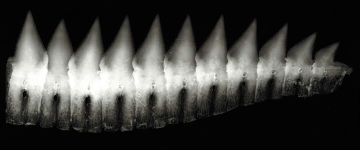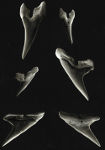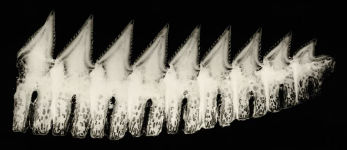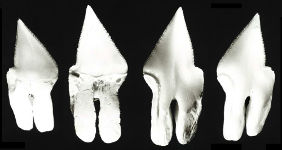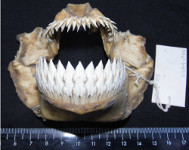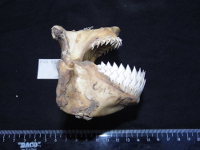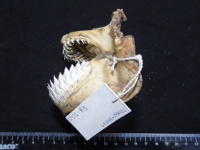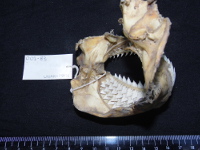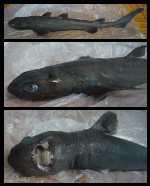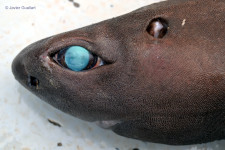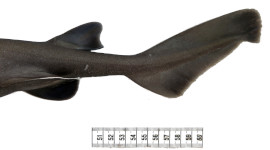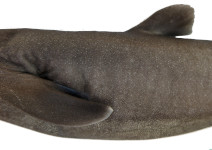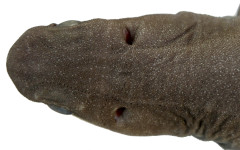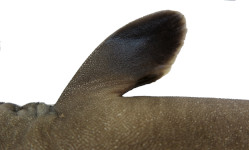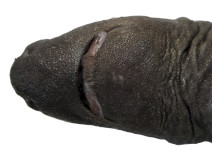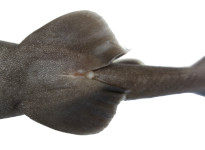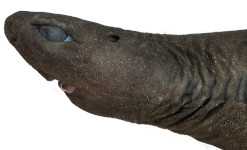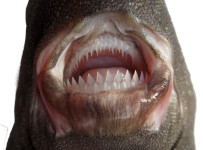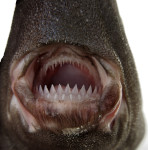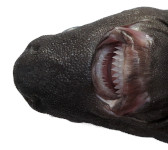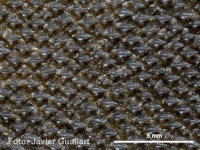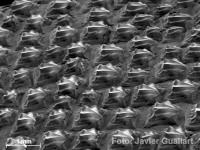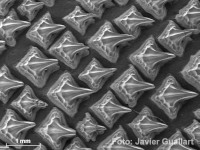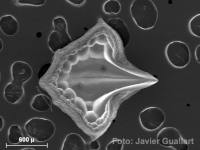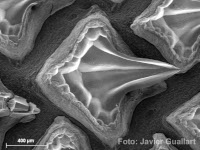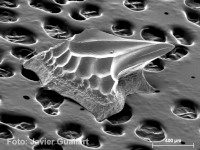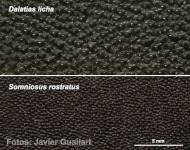Dalatias licha
(Bonnaterre, 1788)
Kitefin shark
Classification: Elasmobranchii Squaliformes Dalatiidae
Reference of the original description
Ichthyologie. Tableau encyclopédique et méthodique des trois règnes de la nature. Paris, 215 p., pl. A–B + 1–100.
Ichthyologie. Tableau encyclopédique et méthodique des trois règnes de la nature. Paris, 215 p., pl. A–B + 1–100.
Image of the original description
No image in first description.
No image in first description.
Synonyms / new combinations and misspellings
Dalatias brevipinnis, Dalatias cf. licha, Dalatias lica, Dalatias lichia, Dalatias phillippsi, Dalatias sparophagus, Dalatias tachiensis, Pseudoscymnus boshuensis, Scimnus phillippsi, Scymnorhinus brevipinnis, Scymnorhinus licha, Scymnorhinus lichia, Scymnorhinus phillippsi, Scymnus licha, Scymnus lichia, Scymnus nicaeensis, Scymnus vulgaris, Scymnus (Scymnus) lichia, Squalus americanus, Squalus licha, Squalus nicaeensis, Squalus nicensis, Squalus scymnus
Dalatias brevipinnis, Dalatias cf. licha, Dalatias lica, Dalatias lichia, Dalatias phillippsi, Dalatias sparophagus, Dalatias tachiensis, Pseudoscymnus boshuensis, Scimnus phillippsi, Scymnorhinus brevipinnis, Scymnorhinus licha, Scymnorhinus lichia, Scymnorhinus phillippsi, Scymnus licha, Scymnus lichia, Scymnus nicaeensis, Scymnus vulgaris, Scymnus (Scymnus) lichia, Squalus americanus, Squalus licha, Squalus nicaeensis, Squalus nicensis, Squalus scymnus
Types
Dalatias licha
Holotype: MNHN: lost
Dalatias tachiensis
Holotype: NTUM: 7234001;
Pseudoscymnus boshuensis
Holotype: SU: 29535
Scymnorhinus brevipinnis
Holotype: SAIAB: 27;
Scymnorhinus lichia
XXXX: No types known;
Scymnorhinus phillippsi
Holotype: AMS: E.3702; Paratype: AMS: E.5532; AMS: I.12876; AMS: I.12875; AMS: I.12875.001;
Scymnus vulgaris
XXXX: No types known;
Squalus americanus
XXXX: No types known;
Squalus nicaeensis
Syntype: MNHN: B-0842
Squalus scymnus
XXXX: No types known;
Dalatias licha
Holotype: MNHN: lost
Dalatias tachiensis
Holotype: NTUM: 7234001;
Pseudoscymnus boshuensis
Holotype: SU: 29535
Scymnorhinus brevipinnis
Holotype: SAIAB: 27;
Scymnorhinus lichia
XXXX: No types known;
Scymnorhinus phillippsi
Holotype: AMS: E.3702; Paratype: AMS: E.5532; AMS: I.12876; AMS: I.12875; AMS: I.12875.001;
Scymnus vulgaris
XXXX: No types known;
Squalus americanus
XXXX: No types known;
Squalus nicaeensis
Syntype: MNHN: B-0842
Squalus scymnus
XXXX: No types known;
Description :
Citation: Dalatias licha (Bonnaterre, 1788): In: Database of modern sharks, rays and chimaeras, www.shark-references.com, World Wide Web electronic publication, Version 11/2024
Please send your images of "Dalatias licha" to info@shark-references.com
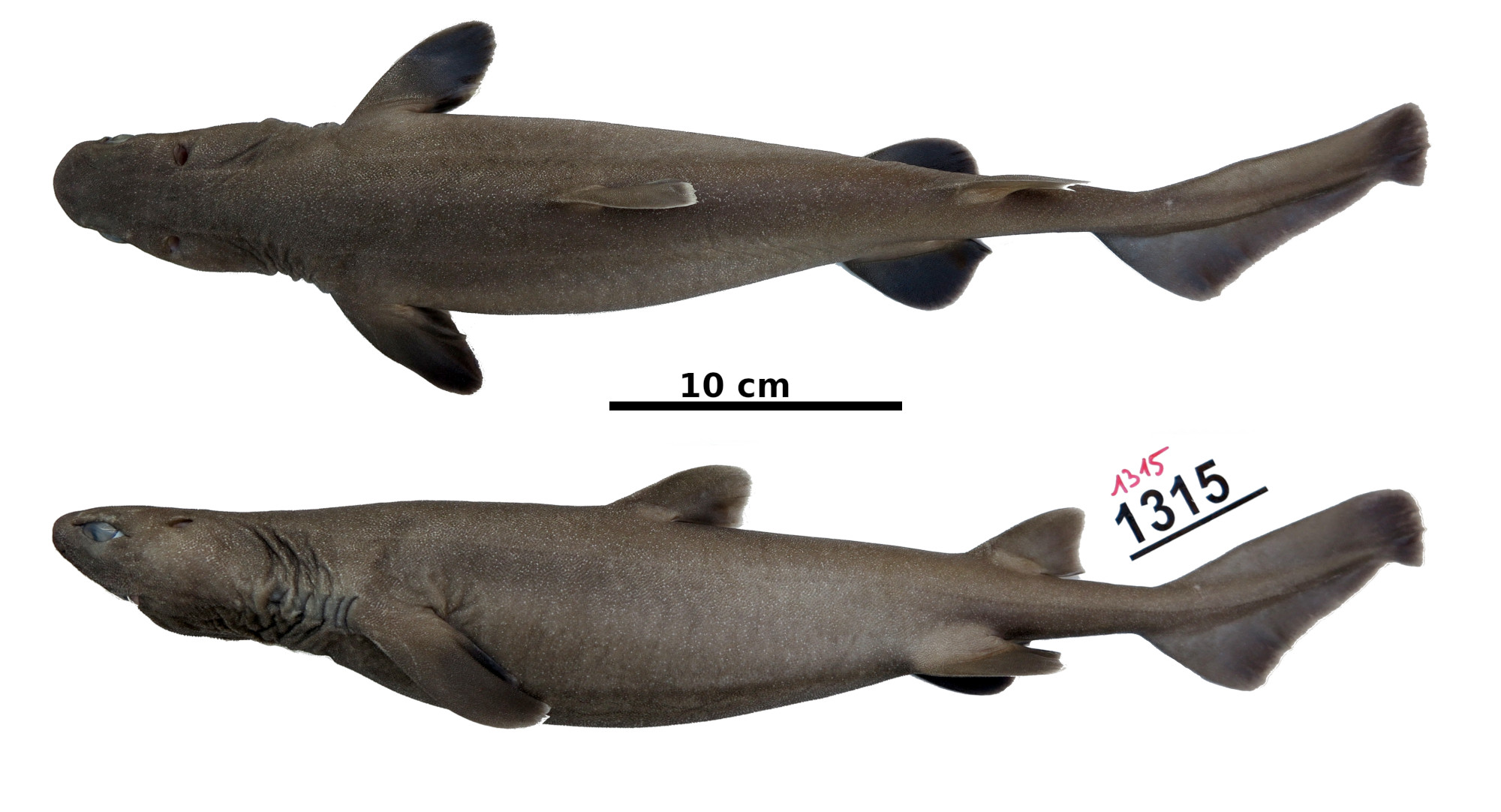
Dalatias licha (Bonnaterre, 1788), ERB 1315, female, 49,9 cm TL, NE Atlantic, France © Frederik H. Mollen (Elasmobranch Research Belgium)

Dalatias licha (Bonnaterre, 1788), ERB 1315, female, 49,9 cm TL, NE Atlantic, France © Frederik H. Mollen (Elasmobranch Research Belgium)
Common names
 Darkie Charlie,
Darkie Charlie,  Dunkler Hai,
Dunkler Hai,  Schokoladenhai,
Schokoladenhai,  Carocho,
Carocho,  Gata,
Gata,  Gata tramolla,
Gata tramolla,  Lija,
Lija,  Lija negra,
Lija negra,  Squale liche,
Squale liche,  Black shark,
Black shark,  Darkie charlie,
Darkie charlie,  Kitefin shark,
Kitefin shark,  Kitefm Shark,
Kitefm Shark,  Seal shark,
Seal shark,  Cani monicu,
Cani monicu,  Diavolo,
Diavolo,  Diavulu di funnu,
Diavulu di funnu,  Naire,
Naire,  Neigra,
Neigra,  Paddottula,
Paddottula,  Stire verde,
Stire verde,  Zegrine,
Zegrine,  Zigrino,
Zigrino,  Zigrino negro,
Zigrino negro,  Carocho,
Carocho,  Gata,
Gata,  Gata-lixa,
Gata-lixa,  Gato,
Gato,  Lixa-de-pau,
Lixa-de-pau,  Negra,
Negra,  Pailona,
Pailona,  Peixelim,
Peixelim,  Trabolha, Murruna sewda (malta)
Trabolha, Murruna sewda (malta)
 Darkie Charlie,
Darkie Charlie,  Dunkler Hai,
Dunkler Hai,  Schokoladenhai,
Schokoladenhai,  Carocho,
Carocho,  Gata,
Gata,  Gata tramolla,
Gata tramolla,  Lija,
Lija,  Lija negra,
Lija negra,  Squale liche,
Squale liche,  Black shark,
Black shark,  Darkie charlie,
Darkie charlie,  Kitefin shark,
Kitefin shark,  Kitefm Shark,
Kitefm Shark,  Seal shark,
Seal shark,  Cani monicu,
Cani monicu,  Diavolo,
Diavolo,  Diavulu di funnu,
Diavulu di funnu,  Naire,
Naire,  Neigra,
Neigra,  Paddottula,
Paddottula,  Stire verde,
Stire verde,  Zegrine,
Zegrine,  Zigrino,
Zigrino,  Zigrino negro,
Zigrino negro,  Carocho,
Carocho,  Gata,
Gata,  Gata-lixa,
Gata-lixa,  Gato,
Gato,  Lixa-de-pau,
Lixa-de-pau,  Negra,
Negra,  Pailona,
Pailona,  Peixelim,
Peixelim,  Trabolha, Murruna sewda (malta)
Trabolha, Murruna sewda (malta)
Short Description
Description after Ebert, 2013 [19900]: Diagnostic Features: Anterior nasal flaps short, not expanded into barbels; snout broadly conical, rounded, and short, length much less than distance from mouth to pectoral–fin origins and about 1/4 of head length; gill openings moderately broad and about equally wide; lips very thick, fringed or pleated, not suctorial. Both dorsal fins without spines; first dorsal–fin origin somewhat behind free rear tips of pectoral fins, first dorsal–fin insertion well anterior to pelvic–fin origins, closer to pectoral–fin bases than pelvic fins; second dorsal–fin origin about over middle of pelvic–fin bases; second dorsal fin only slightly larger than first, its base less than 1.5 times first dorsal–fin base; pectoral fins with short, broadly rounded free rear tips, not broadly lobate or acute and elongated; caudal fin asymmetrical, not paddle–shaped, upper lobe long, lower lobe very short or virtually absent, subterminal notch well–developed. No precaudal pits or lateral keels on caudal peduncle. Dermal denticles with low flat, ridged, unicuspid crowns, not pedicellate. Cloaca is without a luminous gland. Vertebral counts: total vertebral counts 78 to 85, precaudal vertebral counts 47 to 55. Colour: greyish to black or blackish brown, sometimes violet with black spots.
Field Marks: A moderate–sized, short– and blunt–snouted shark with two almost equal–sized spineless dorsal fins, no anal fin, papillose thick lips, small slender–cusped upper teeth and very large lower teeth with erect triangular serrated cusps and distal blades, first dorsal fin on back with its origin behind the pectoral–fin rear tips and its base closer to the pectoral–fin base than the pelvic fins, and caudal fin with the ventral lobe not expanded.
Description after Ebert, 2013 [19900]: Diagnostic Features: Anterior nasal flaps short, not expanded into barbels; snout broadly conical, rounded, and short, length much less than distance from mouth to pectoral–fin origins and about 1/4 of head length; gill openings moderately broad and about equally wide; lips very thick, fringed or pleated, not suctorial. Both dorsal fins without spines; first dorsal–fin origin somewhat behind free rear tips of pectoral fins, first dorsal–fin insertion well anterior to pelvic–fin origins, closer to pectoral–fin bases than pelvic fins; second dorsal–fin origin about over middle of pelvic–fin bases; second dorsal fin only slightly larger than first, its base less than 1.5 times first dorsal–fin base; pectoral fins with short, broadly rounded free rear tips, not broadly lobate or acute and elongated; caudal fin asymmetrical, not paddle–shaped, upper lobe long, lower lobe very short or virtually absent, subterminal notch well–developed. No precaudal pits or lateral keels on caudal peduncle. Dermal denticles with low flat, ridged, unicuspid crowns, not pedicellate. Cloaca is without a luminous gland. Vertebral counts: total vertebral counts 78 to 85, precaudal vertebral counts 47 to 55. Colour: greyish to black or blackish brown, sometimes violet with black spots.
Field Marks: A moderate–sized, short– and blunt–snouted shark with two almost equal–sized spineless dorsal fins, no anal fin, papillose thick lips, small slender–cusped upper teeth and very large lower teeth with erect triangular serrated cusps and distal blades, first dorsal fin on back with its origin behind the pectoral–fin rear tips and its base closer to the pectoral–fin base than the pelvic fins, and caudal fin with the ventral lobe not expanded.
Distribution
Western Atlantic: Georges Bank and northern Gulf of Mexico. Eastern Atlantic: Iceland [20065], Scotland, and Irish Atlantic slope to Morocco, western Mediterranean, Madeira to Cameroon. Western Indian Ocean: Mozambique and South Africa. Western Pacific: Japan, Australia, and New Zealand. Central Pacific: Hawaii. Source: www.gbif.org
Western Atlantic: Georges Bank and northern Gulf of Mexico. Eastern Atlantic: Iceland [20065], Scotland, and Irish Atlantic slope to Morocco, western Mediterranean, Madeira to Cameroon. Western Indian Ocean: Mozambique and South Africa. Western Pacific: Japan, Australia, and New Zealand. Central Pacific: Hawaii. Source: www.gbif.org
Human uses
fisheries: minor commercial; price category: medium; price reliability: reliable: based on ex-vessel price for this species
fisheries: minor commercial; price category: medium; price reliability: reliable: based on ex-vessel price for this species
Biology
Ovoviviparous [518]. 10-20 young born at 30-42 cm [578]; 10-16 young born at 30 cm TL [2539]. Distinct pairing with embrace [17086]. Found on the continental shelf and slope (Ref. 75154). Feeds on fish and benthic organisms (Ref. 568).
Ovoviviparous [518]. 10-20 young born at 30-42 cm [578]; 10-16 young born at 30 cm TL [2539]. Distinct pairing with embrace [17086]. Found on the continental shelf and slope (Ref. 75154). Feeds on fish and benthic organisms (Ref. 568).
Size / Weight / Age
182 cm TL (male/unsexed; [20048]); TL (mature): male: ~100 cm, female: ~120 cm; TL (birth): 30-40 cm [19900]
182 cm TL (male/unsexed; [20048]); TL (mature): male: ~100 cm, female: ~120 cm; TL (birth): 30-40 cm [19900]
Dentition
teeth very different in upper and lower jaws, uppers small, with narrow, hooked, needle–shaped cusps and no cusplets, lowers very large, bladelike, interlocked, with broad, erect, triangular cusps, small distal blades, and serrated edges; tooth row counts 16 to 21 upper jaw, 17 to 20 lower jaw tooth [19900]; formula (upper/lower): 16-21/17-20 [17836];
copyright by: Imaging and Analysis Centre, Natural History Museum
Links: SEM-images of teeth
teeth very different in upper and lower jaws, uppers small, with narrow, hooked, needle–shaped cusps and no cusplets, lowers very large, bladelike, interlocked, with broad, erect, triangular cusps, small distal blades, and serrated edges; tooth row counts 16 to 21 upper jaw, 17 to 20 lower jaw tooth [19900]; formula (upper/lower): 16-21/17-20 [17836];
copyright by: Imaging and Analysis Centre, Natural History Museum
Links: SEM-images of teeth
Parasites (arranged by Jürgen Pollerspöck)
Monogenea
Cestoda
Trematoda
Nematoda
Monogenea
- Septitrema lichae Kheddam, Chisholm & Tazerouti, 2020 [28981]
- Squalonchocotyle euzeti Kheddam, Justine & Tazerouti, 2016 [24914]
Cestoda
- Crossobothrium dohrnii (Oerley, 1885) Ruhnke, 1996 [16443]
- Grillotia heptanchi (Vaullegeard, 1899) [16112]
- Grillotia institata (Pintner, 1931) [16112]
- Grillotia scolecina (Rudolphi, 1819) [16112]
- Grillotia sp. [30169]
- Hepatoxylon megacephalum (Rudolphi, 1819) [16602] [21481] [16112]
- Hepatoxylon trichiuri (Holten, 1802) [21481] [16112]
- Monorygma hyperapolytica (Obersteiner, 1914) [16245] [16443] [16602] [20495]
- Sphyriocephalus viridis (Wagener, 1854) Pintner, 1913 [16112] [15747] [25091]
Trematoda
Nematoda








